Introduction To Edge Computing
Edge Computing is also called a “Distributed Computing Model”. Edge Computing can work with great speed and efficiency.
This is because all the computational resources are kept or installed near the data sources, and hence the roundup trips are restricted, eventually consuming less energy.
This reduces Latency and enhances overall performance. Various factors on how can edge computing be used to improve sustainability are discussed in detail.
In Edge computing, the computing resources are used and utilized, such as servers, storage, and network devices at the network’s edge.
The data and information are transferred to a closer distance; hence, bandwidth and storage consumption are reduced because of data encryption.
What is Edge Computing?
Edge computing relies not heavily on remote or cloud services or centralized data centers like cloud computing.
The primary advantage of edge computing is reducing Latency and bandwidth usage by processing, analyzing, and handling data locally to avoid heavy traffic and network congestion.
The data and information are secured, as edge computing offers an additional layer of security and data encryption; this encrypted data and information is not accessible to end users.
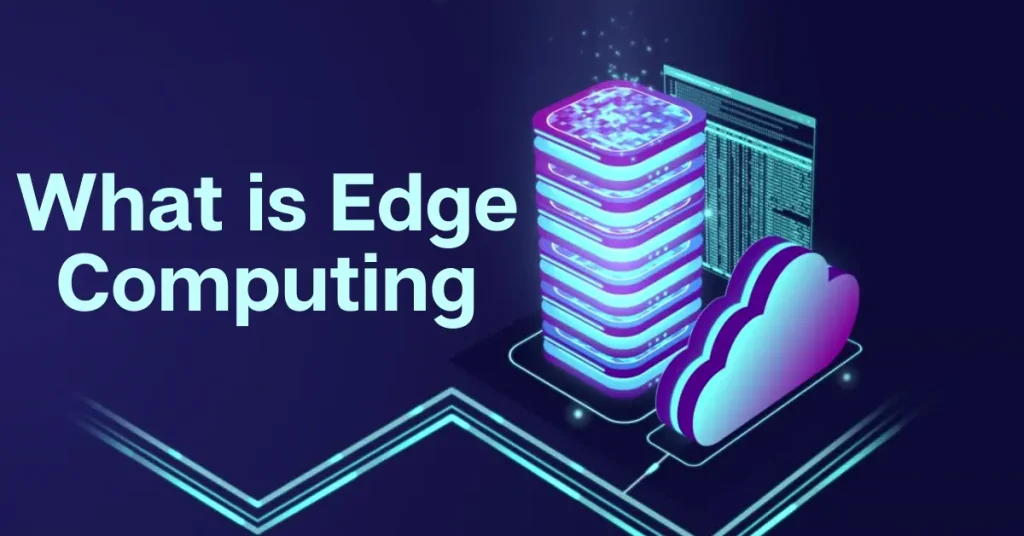
This encrypted data and information is unavailable to unauthorized users and hackers. Edge computing also focuses on cyber security issues that arise in other networks.
There are several other benefits of edge computing over other computing, some of which are mentioned below.
- Centralized Data Processing.
- Reduces Latency.
- Response Times.
- Improved Network Traffic.
- Enhanced Performance.
- Efficiency.
How Can Edge Computing be Used to Improve Sustainability in Tabular Form
Edge Computing is equipped with the capabilities to improve sustainability.
| 1 | Energy Efficiency. |
| 2 | Real-Time Analytics. |
| 3 | Precision Agriculture. |
| 4 | Smart Grid Management. |
| 5 | Environmental Monitoring. |
| 6 | Smart Building Management. |
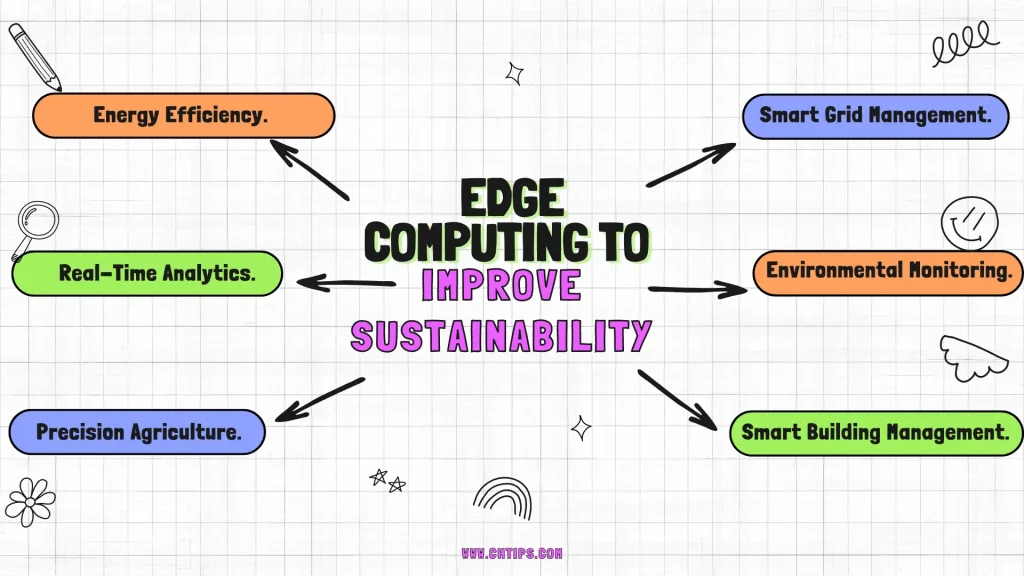
1. Energy Efficiency.
In Edge Computing, the data and information are processed and handled locally; the data are not sent to the cloud server for further processing.
This eventually reduces energy consumption overall.
This also eliminates carbon footprints linked with transferring data and information.
2. Real-Time Analytics.
Edge Computing enables real-time analytics that help in reducing energy consumption. This maximizes efficiency.
3. Precision Agriculture.
Edge Computing also enables the user to collect, identify, recognize, and analyze data | information for further processing and studying.
This data helps farmers act appropriately regarding crop cultivation, management, and optimizing yields.
4. Smart Grid Management.
Edge Computing can be used, utilized, and manage the power grid more efficiently.
The data is collected in real-time; grid operators can better predict demand, adjust production and distribution accordingly, and reduce unnecessary energy waste.
5. Environmental Monitoring.
Edge Computing can monitor environmental conditions that allow real-time data analysis for improving and identifying potential hazards.
6. Smart Building Management.
Edge computing can be used for intelligent building management systems to optimize energy efficiency by controlling lighting, heating, cooling, and other systems in real-time, reducing unnecessary energy consumption.
Overall, edge computing has the potential to improve sustainability by maximizing energy efficiency and reducing environmental impact in many industries.
What is the Main Purpose of Edge Computing?
Edge computing allows computational capabilities closer to the data centers or the endpoints so that data can be transported from one end to another quickly and accurately.
The data is handled and processed locally, hence reducing Latency.
The data is encrypted, so the bandwidth needed is considerably reduced compared to cloud computing.
Edge computing is primarily and extensively used and utilized in real-time applications and projects where instant data and information is needed from the server.
Some of the Edge computing applications are as follows.
- Internet of Things (IoT).
- Online Gaming.
- Automated Cars.
- Augmented / Virtual Reality.
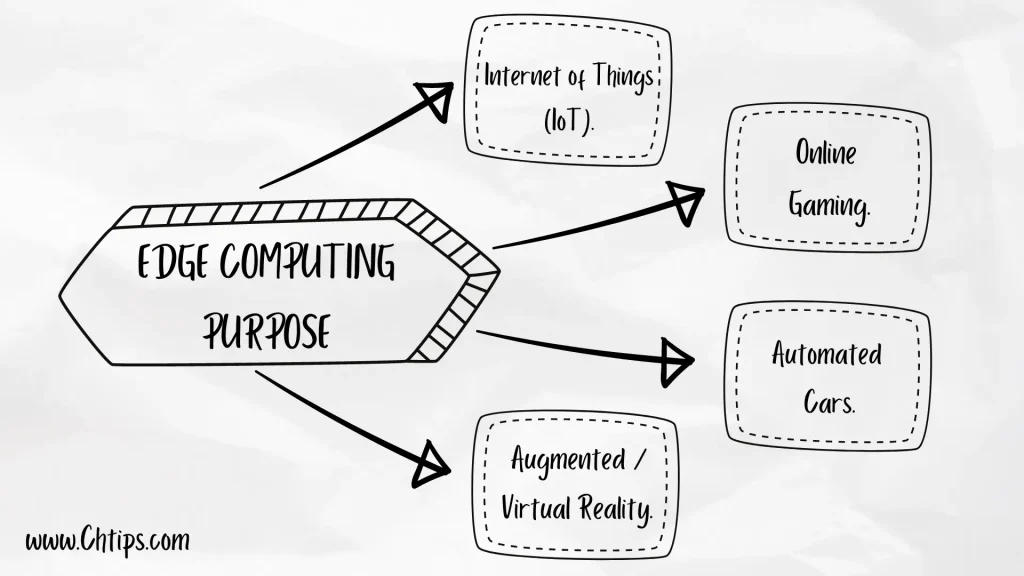
Edge computing also enables data privacy and security by limiting the exposure of sensitive data to the public internet.
What are the Benefits of Edge Computing in Cloud Computing?
There are several significant benefits of edge computing in cloud computing. Some of them are listed below.
- Energy Efficiency.
- Reduced Carbon Footprint.
- Conservation of Resources.
- Scalability.
- Sustainable Business Models.
How Does Cloud Computing Affect Sustainability?
- Green Data Centers.
- Reduced E-Waste.
- Collaboration and Resource Sharing.
- Reduced Paper Usage.
What are the Sustainability Benefits of the Cloud?
- Reduced Energy Consumption.
- Reduced Carbon Footprint.
- Efficient Resource Utilization.
- Remote Access.
- Green Hosting.
- Sustainable Business Models.
- Conservation of Resources.
6 Applications of Edge Computing
- Smart Cities.
- Industrial Internet of Things (IIoT).
- Autonomous Vehicles.
- Healthcare.
- Energy.
- Agriculture.
7 Examples of Edge Computing
- Autonomous Vehicles.
- 5G Connectivity.
- Healthcare.
- Telecommunications.
- Autonomous Vehicles.
- Predictive Maintenance.
- Voice Assistant.
Features of Edge Computing
Edge computing is preferred over cloud computing due to some significant and impressive features that are related to edge computing.
Some of the features of edge computing are included below.
- Low Latency.
- Security.
- Reduced Network Traffic.
- Scalability.
- Reliability.
- Cost-Effectiveness.
- Autonomous Computing.
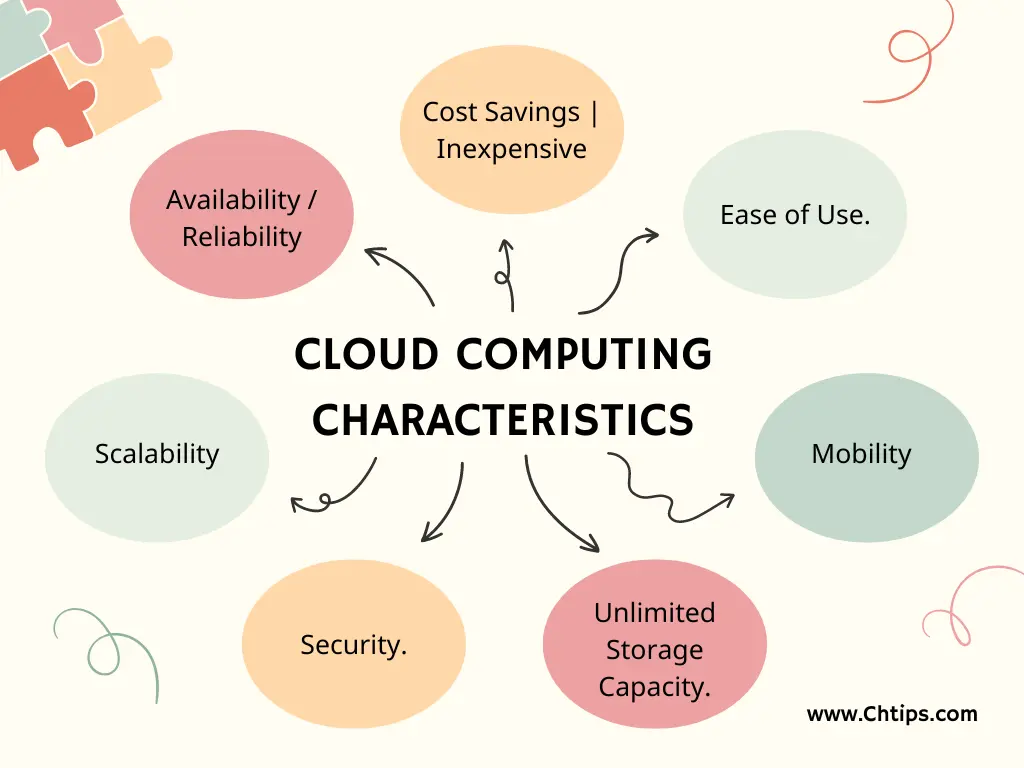
1. Low Latency.
Edge computer is widely used and utilized due to their low Latency and speed in which it transfers data and information over the network.
Data and information are stored and processed locally for better performance and usability. The data source is kept or installed near the computing power for faster processing speed.
2. Security.
Edge Computing offers an additional layer of security for the users as the data and information is processed and handled locally.
Therefore, sensitive and personal data is not transferred over the network, avoiding the risk of cyber-attacks and data breaches.
3. Reduced Network Traffic.
Edge Computing reduces network traffic to an extent because the data is processed and handled locally. Also, the traffic is encrypted.
Edge Computing transmits the data on the cloud that is relevant and necessary to avoid congestion in the network.
4. Scalability.
Edge Computing allows additional devices and resources to be added to the network to handle vast volumes of data and information.
5. Reliability.
Edge Computing offers various significant features and characteristics, and hence businesses can instantly access the data and information to take appropriate action for their benefit.
6. Cost-Effectiveness.
Edge Computing avoid expensive hardware devices and resources used in data | information access and sharing; they also considerably reduce infrastructure and bandwidth, resulting in low expenses.
7. Autonomous Computing.
They also are known as “Autonomous Computing” because most of the data processing is performed locally, without the constant requirement of a cloud or data center.
This results in better functionality and performance.
4 Types of Edge Computing
There are 4 types of edge computing.
- Internet of Things Edge.
- On-Premise Edge.
- Access Edge.
- Network Edge.
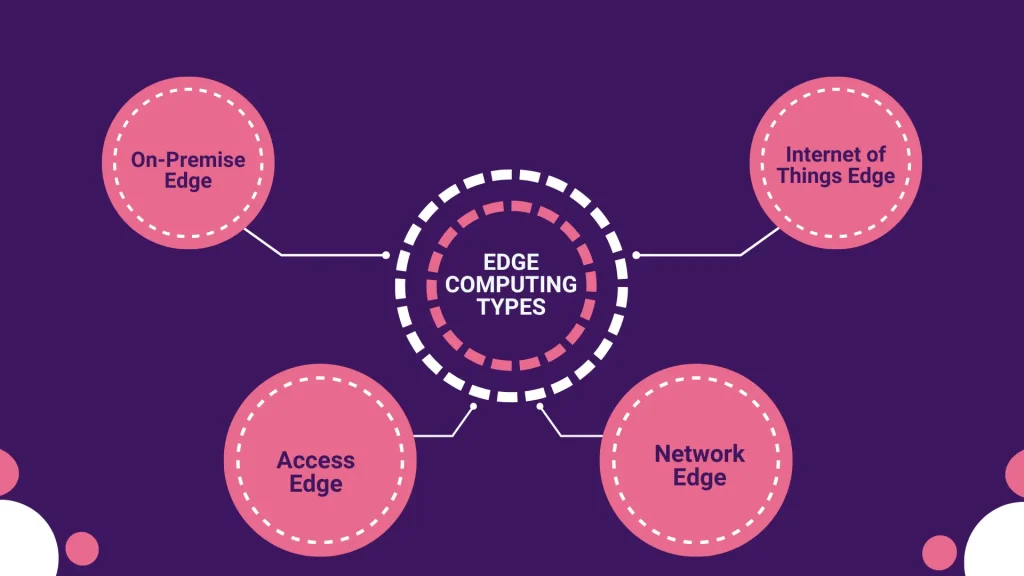
Edge Computing be Used to Improve Sustainability PDF Download
Recommended Reading
- Which Statement Describes A Characteristic of Cloud Computing
- Top 10+ Pros and Cons of Digital Transformation and Workplace
- 6+ Different Types of Records Management Software
- Which Factors Have Made Edge Computing Cheaper and Easier?
- How Does Edge Computing Reduce Latency For End Users
- What is Integrated Document Management System | 4 Types , Components and Examples
- Data Protection for Websites in the Tech Domain
- Computer Basic Tutorials
- Cloud Computing
Useful Video: Edge Computing Sustainability
Top Edge Computing Companies
| 1 | Microsoft. |
| 2 | Cisco. |
| 3 | Fastly. |
| 4 | IBM. |
| 5 | EdgeConneX. |
| 6 | Amazon. |
| 7 | AWS. |
| 8 | Intel Corporation. |
| 9 | Hewlett Packard Enterprises. |
Frequently Asked Questions [FAQs] On Edge Computing Sustainability
Edge Stands for
Enhanced Data rates for GSM Evolution (EDGE).
Is Edge Computing the Future?
Yes, the future of edge computing is very bright.
Which is Better, Cloud or Edge?
Edge Computing is better than the cloud as it works and processes the data | and information faster with low Latency.
Is 5G Edge Computing?
Edge Computing is merged or combined with 5G.
Is Netflix Edge Computing?
To improve the overall experience, with speed to access data, Netflix has moved to Edge Computing.
Who is leading in Edge Computing?
Azure.
Clear Blade.
Dell.
Edge ConneX.
Is Alexa Edge Computing?
Yes.
Get In Touch
I have also written and compiled some articles on computers and telecommunications, and please go through them.
I hope you will like reading it.
All the questions and queries related to the How Can Edge Computing be Used to Improve Sustainability 5 Reasons You Never Knew have been answered here.
If you have any questions related to What is Edge Computing.
Don’t hesitate to contact me, and if you need to add, remove, or update anything from the article, please let me know in the comment section or via email.
I will be more than happy to update the article. I am always ready to correct myself.
I would like you to share this article with your friends and colleagues; this motivates me to write more on related topics.
!!! Thank You !!!